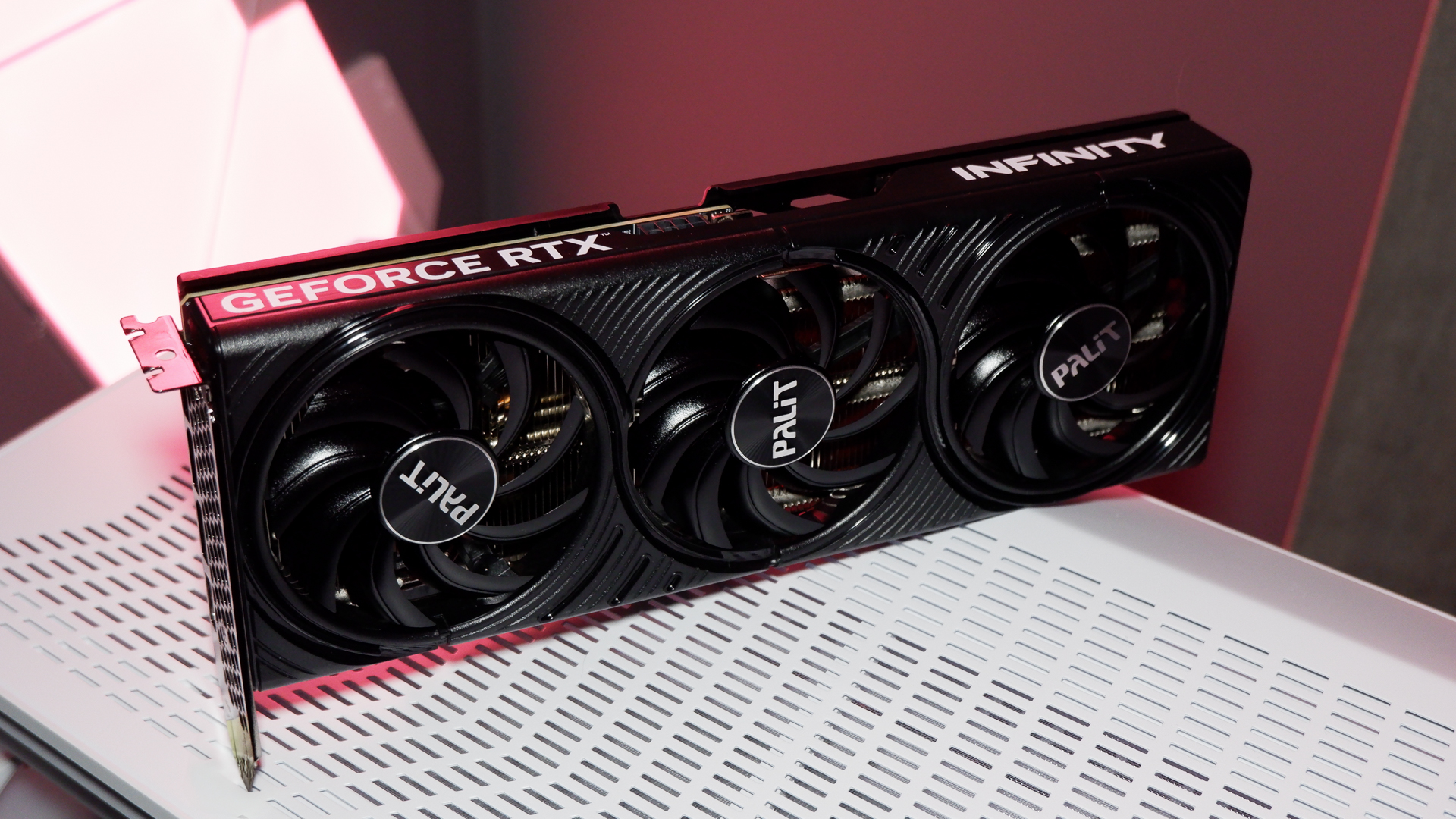Our Verdict
The GeForce RTX 2080 Ti takes down 4K and includes a ton of new features, but pricing is a significant hurdle.
For
- Fastest single GPU
- Built for the future
- 4K and HDR become achievable
Against
- Big price jump from 1080 Ti
- Needs a beefy system
PC Gamer's got your back
The king is dead, long live the king! The Nvidia GeForce RTX 2080 Ti is the heavyweight champion of the graphics cards and has remained so since it was first launched back at the tail end of 2018. Using Nvidia's Turing architecture with support for real-time ray tracing, plus Tensor cores for deep learning applications, it's still the most advanced graphics chip around and currently powers the best gaming PCs. But there's one serious, almost inevitable problem: the GeForce RTX 2080 Ti Founders Edition is also the most expensive consumer graphics card Nvidia has ever released.
The RTX 2080 Ti tips the scales at 18.6 billion transistors, which also makes it the largest consumer GPU Nvidia has ever created. It's nearly as big as the Volta GV100 in the $2,999 Titan V and Tesla V100, but it includes significant updates that make it faster and more efficient. You could almost argue the price is a good deal for what you get—but I won't, because $1,199 is the same as the Titan Xp, and Titan cards have always had a ludicrous price to performance ratio.
There are basically two reasons to buy the GeForce RTX 2080 Ti Founders Edition. One is that you simply must have the best / fastest graphics card, cost be damned. The other is that you're convinced the real-time ray tracing and deep learning technologies are going to revolutionize the gaming and graphics industry, and you're willing to be an early adopter. Rumors are that you might be about to feel the pain of the early adopter towards the end of the year if the promises of Nvidia Ampere RTX performance are to be believed...
There may be others, but realistically most PC gamers aren't going to buy the RTX 2080 Ti, since you can build a complete mainstream gaming PC for the same price. I've reviewed the GeForce RTX 2080 Founders Edition separately, and even that card is tough to recommend at $799.

Nvidia deserves credit for not just coasting on Turing. It could have added some additional GPU cores and GDDR6 and called it a day. But it didn't, instead choosing to invest significant resources into reworking the architecture, adding RT cores to make real-time ray tracing possible, and Tensor cores for denoising, DLSS, and other deep learning applications. Those additions could revolutionize games and graphics in the coming years, and without the updated DLSS 2.0 feature there's a real cost to including them. Even then ray tracing performance can be prohibitive.
Nvidia invested significant resources into the Turing architecture, adding RT cores for real-time ray tracing and Tensor cores for deep learning applications.
Take a look at the die size for some perspective. The Turing TU102 and TU104 are both larger than the Pascal GP102, even though the TU104 has 20 percent fewer cores and fewer memory channels.
GPU - Turing TU102
Lithography - TSMC 12nm FinFET
Transistor Count - 18.6 billion
Die Size- 754mm2
Streaming Multiprocessors - 68
CUDA Cores - 4,352
Tensor Cores - 544
RT Cores - 68
Video memory - 11GB GDDR6
Memory bus - 352-bit
Base Clock - 1350MHz
Boost Clock - 1635MHz
Memory Speed - 14 GT/s
Memory Bandwidth - 616GB/s
TDP - 260W
Price - $1,200
Larger die sizes mean lower yields, or at least the need to use harvested chips, and Nvidia nets fewer chips per wafer. That increases costs, as does the move to GDDR6, and there are plenty of other R&D expenses. But Nvidia isn't eating the higher costs, and with effectively no competition to its fastest GPUs, it's passing them to the customer and we're left with a new high-water mark on graphics card prices.
The upgrades to the RTX 2080 Ti Founders Edition are interesting, specifically with the cooling design. Nvidia has moved from its traditional blower-style cooling to dual axial fans, and the heatsink also features a dual vapor chamber for good measure. The stated goal was to reduce fan noise and improve cooling, and noise levels are definitely lower, though I'm not convinced the cards run cooler. Something I want to see is how the custom AIB cards compare with Nvidia's Founders Edition, so keep an eye out for additional graphics card reviews in the coming weeks.

I've talked about pricing already, because it's a major sticking point. The 780 Ti cost $649, the 980 Ti also launched at $649, and the 1080 Ti bumped up to the $699 mark. $1,199 for the initial Founders Edition is a massive jump. There has always been a certain amount of diminishing returns going from budget to midrange to high-end cards, and that's especially true of the GeForce RTX 2080 Ti.
What would it take to justify the expense? Even if the RTX 2080 Ti were twice the performance of a GTX 1080 Ti, is there really a need for it?
If you're running a 1080p monitor, no, and even at 1440p the benefits are debatable. You should be running a 4K or at least ultrawide 3440x1440 display before upgrading to the GeForce RTX 2080 Ti, or you should be gunning for high framerates on a 144Hz 1440p display. Ray tracing at 1080p with DLSS upscaling to 4K is another option, but again that requires a high-end display. We'll have to revisit the ray tracing question once those games start to arrive—a patch for Shadow of the Tomb Raider is likely to come first, or perhaps Battlefield 5 will have it at launch—but here's how the GeForce RTX 2080 Ti Founders Edition performs in current games.

Nvidia RTX 2080 Ti performance
All testing was done using the testbed equipment shown in the boxout to the right. The Core i7-8700K is overclocked to 5.0GHz, thanks to NZXT's Kraken X62 cooling, which does as much as is currently possible to remove CPU bottlenecks from the equation.
The graphics cards used here are 'reference' models, except for the R9 390 and the new GeForce RTX Founders Editions. That does skew things slightly more in favor of the newer cards, by about five percent. I'll be testing additional RTX cards in the coming weeks, and similar factory overclocks are available on virtually every GPU. I'll also be doing some manual overclocking tests in the near future, but was unable to do so in advance due to time constraints.
All the games are running at 'maximum' quality, within reason—meaning, I didn't use super-sampling or any resolution scaling. I did enable all the advanced graphics settings in GTA5, however, and HBAO+ under the post-processing settings in The Witcher 3. I've also tested with HDR output enabled in the five games that support it, though testing with HDR modes was limited to the RTX 2080 Ti for now (due to time constraints). Several games use more than 8GB VRAM at the tested settings, which will seriously punish older cards with 4GB or less memory. I've included 1080p testing below, but it's mostly as a point of curiosity—as I mentioned before, buying this sort of graphics card for a 1080p display is overkill.


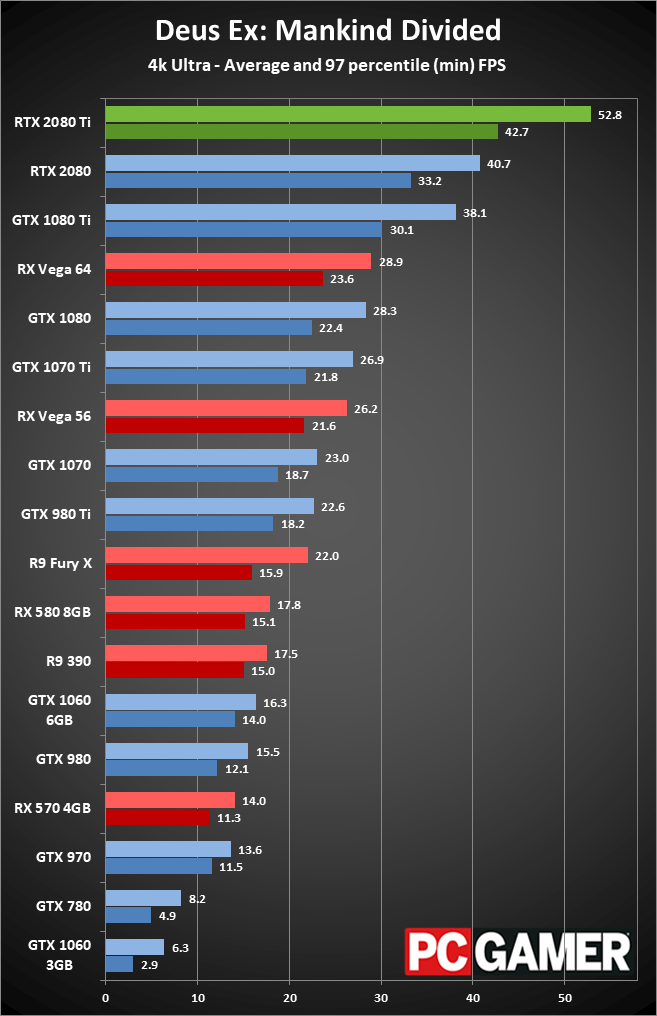
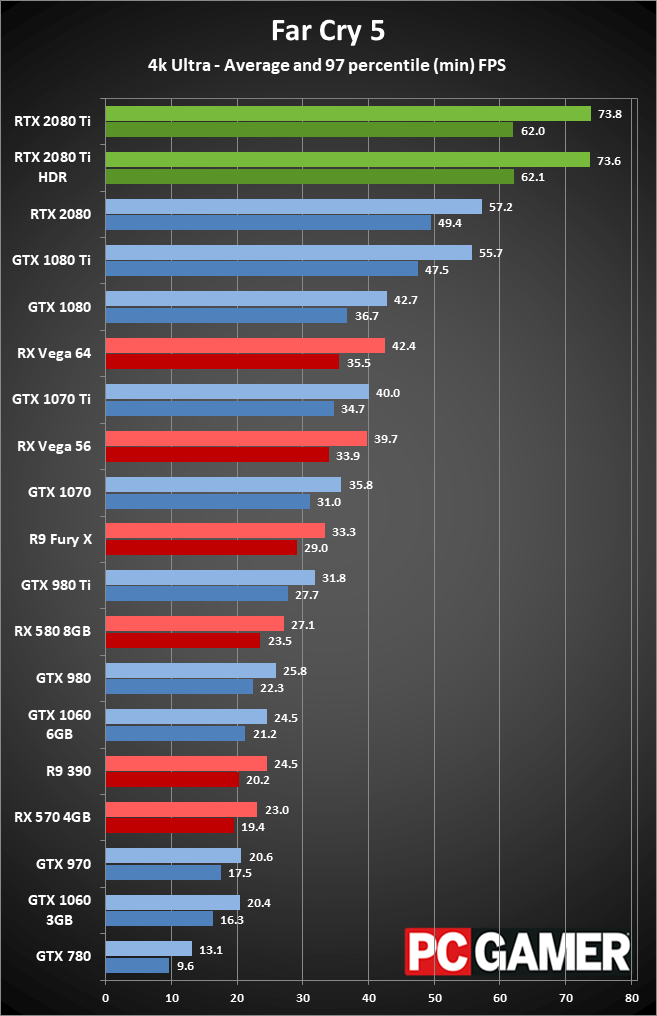



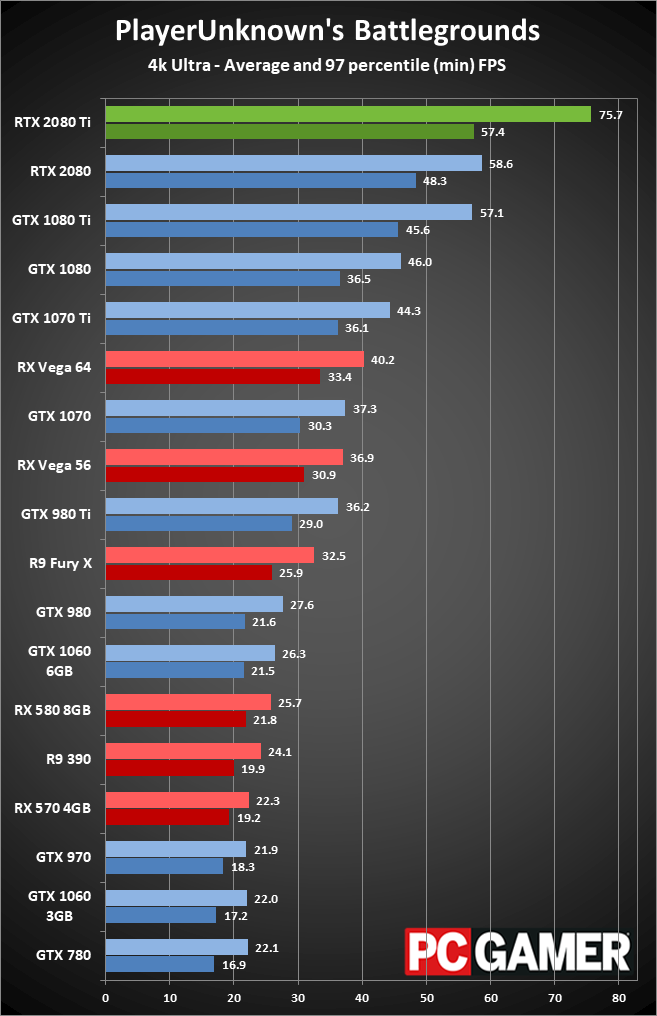





Say what you will about the price, but the 4K performance of the GeForce RTX 2080 Ti is certainly impressive. Minimum framerates are often equal to the average framerates of the RTX 2080 and GTX 1080 Ti, and overall performance is over 30 percent higher. Of the twelve games tested, only two fail to average more than 60fps, and both could easily hit that mark with a few minor tweaks to the settings—Deux Ex at very high instead of ultra, for example, and disable or turn down a few of the advanced settings in GTA5. There's no question the RTX 2080 Ti is the fastest GPU now, only whether you want one and can afford it.










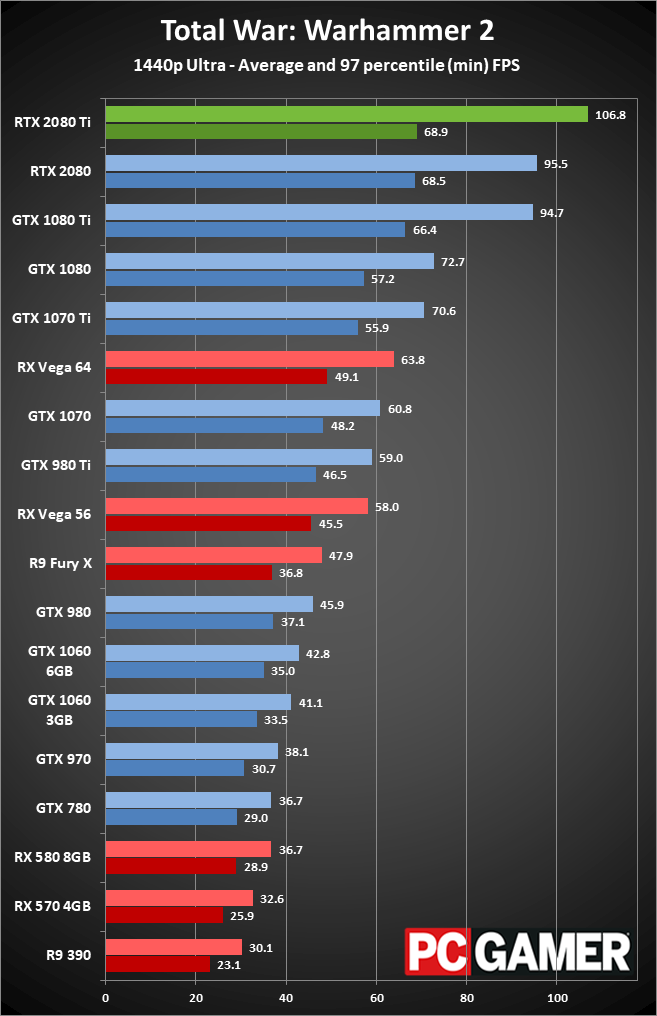


Even with a beastly testbed, CPU bottlenecks start to limit performance of the GeForce RTX 2080 Ti at 1440p. That's unfortunate, as it means maxing out a 144Hz display isn't always possible—in fact, only four of the games tested break 140fps averages. Instead of the 33 percent lead it had over the 1080 Ti at 4K, we have a 27 percent lead—and it drops even more at 1080p.








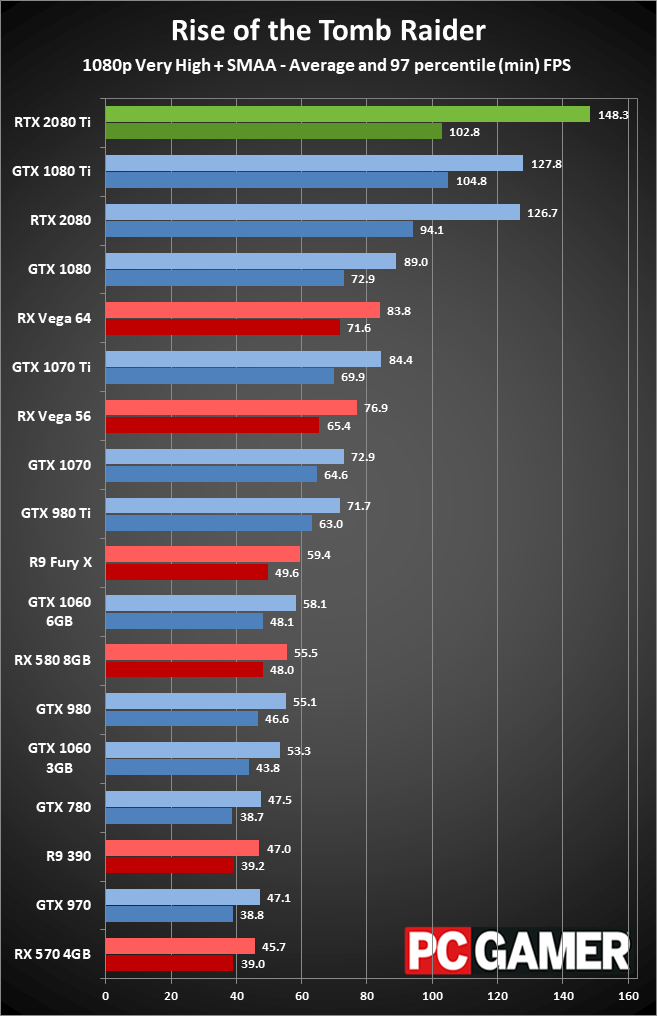









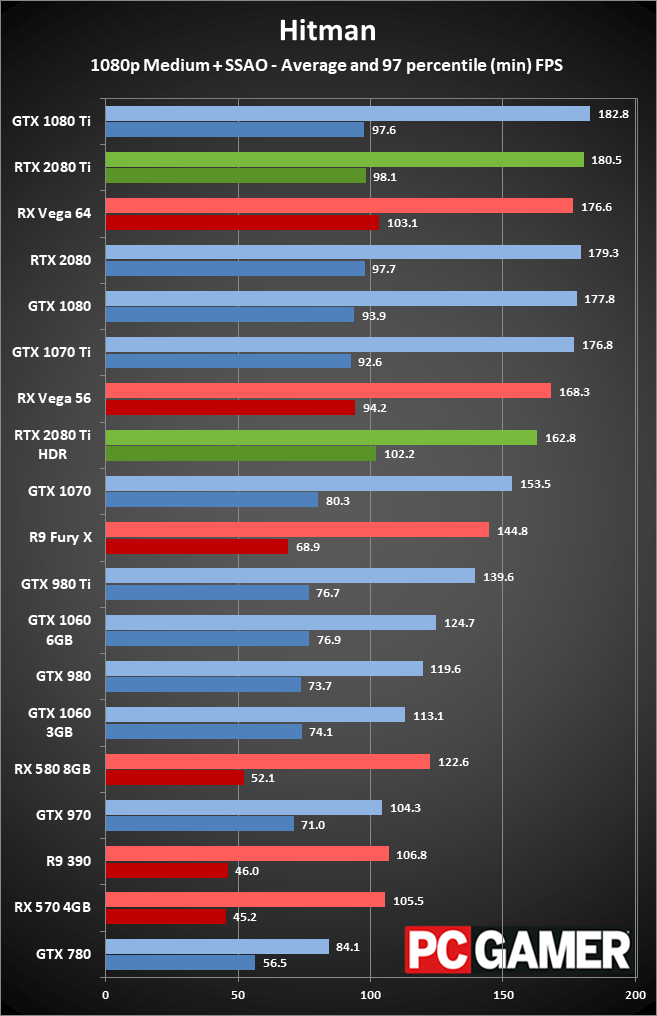







The 1080p results aren't particularly meaningful, though they do give a hint of what we see with DLSS enabled games. Those can render at lower resolutions and upscale to 4K, with 'similar' quality to native 4K with TAA rendering. But if you're using a 1080p display, you really ought to upgrade that before buying a GeForce RTX 2080 Ti Founders Edition—the new Acer Predator X27 or Asus ROG Swift PG27UQ would be a great extreme enthusiast pairing for a 2080 Ti, since money is no object, right?
As with the RTX 2080, I'm somewhat disappointed by the performance results from the GeForce RTX 2080 Ti. It's extremely fast, but it's also packing 20 percent more CUDA cores than the 1080 Ti, and it even has a clockspeed advantage. Nvidia's claims of 50 percent more efficient shaders don't seem to hold up, unless Nvidia is also accounting for power efficiency—something I'll be investigating more in the coming weeks.
Nvidia RTX 2080 Ti value proposition
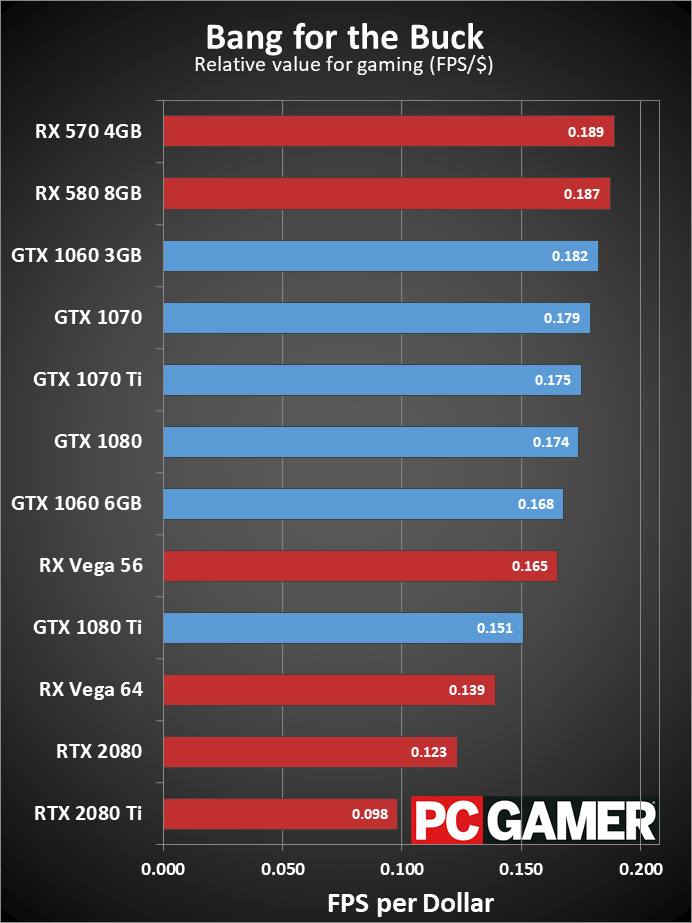





Taking a different view of performance, here's how the current generation graphics cards match up against the GeForce RTX 2080 Ti. I'm including 1080p, 1440p, and 4K results when calculating fps/$, but even if I stick to 4k performance the Turing cards don't provide a compelling value. The real question is this: How excited are you for games to include high quality real-time ray tracing?
If your answer to that question is a nonchalant shrug, give it a pass for now. It's doubtful the cards will increase in price over the coming months, and there's a chance AMD will show up with a new graphics card in 2019 that could push prices down on the GeForce RTX offerings. Either way, you're saving money and with any of the above GPUs, you can still get plenty of enjoyment from games.

Nvidia RTX 2080 Ti: A Titan killer at a Titan price
Nvidia has graphics hardware sporting tons of bespoke features, and at least 25 games are slated to use one or more of the new rendering modes. Combined with improvements from further driver tuning, the GeForce RTX 2080 Ti might increase the performance gap another 10 percent or more and 'normal' rasterization games. And for anything that uses ray tracing—whether that's RTX, DXR, or Vulkan—the Turing cards should hold a commanding lead over any other option.
The problem is that pricing is just too high for me to justify. As usual, owners of Titan cards (all three of you) will now need to look with envy at the RTX 2080 Ti performance, and then wait for the inevitable Titan RTX variant. But even now that has arrived, prices on the RTX 2080 Ti models still haven't fallen to more 'reasonable' levels.

From the performance side of things, it's awesome to see a single graphics card that can consistently break 60fps at 4K. HDR modes don't even cause the card to blink, except for in Hitman where it causes a modest drop in performance, and the number of games that can't handle maxed out 4K is substantially smaller with this card—and 4K high takes care of the small number that fall just short.
You should be running a 4K or at least ultrawide 3440x1440 display before upgrading to the GeForce RTX 2080 Ti.
Everything about the RTX 2080 Ti is extreme, from the design to the specs, the features to the price. I can't in good conscience recommend such a card for most people, but damn if I don't want one. And if you'd bought one at launch, you'll have had the top gaming GPU for around two years now. For those with deep enough pockets, by all means, forget the price and go nuts—it's still the king of the graphics card playground this many years on. If all you care about is extreme performance, pay no heed to the man behind the curtain (ie, the score) and get your game on. The rest of us will watch in envy.
The simple fact is that GeForce RTX 2080 Ti enables a new level of gaming performance. By that token, I find it more desirable than the less expensive RTX 2080. It has more of everything, most critically performance. In that sense it's the new 'best' graphics card. But gamers don't really need it, even in 2020.
The GeForce RTX 2080 Ti takes down 4K and includes a ton of new features, but pricing is a significant hurdle.
Jarred's love of computers dates back to the dark ages when his dad brought home a DOS 2.3 PC and he left his C-64 behind. He eventually built his first custom PC in 1990 with a 286 12MHz, only to discover it was already woefully outdated when Wing Commander was released a few months later. He holds a BS in Computer Science from Brigham Young University and has been working as a tech journalist since 2004, writing for AnandTech, Maximum PC, and PC Gamer. From the first S3 Virge '3D decelerators' to today's GPUs, Jarred keeps up with all the latest graphics trends and is the one to ask about game performance.



